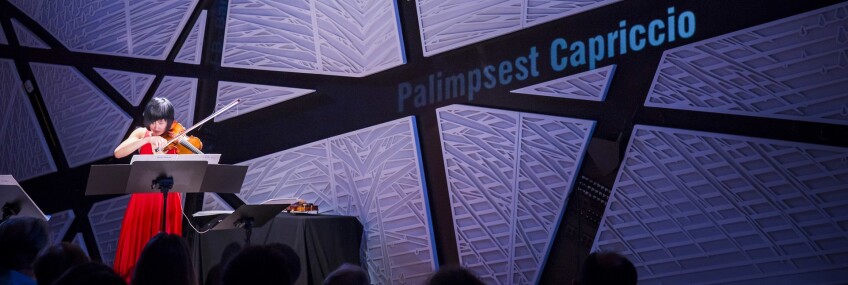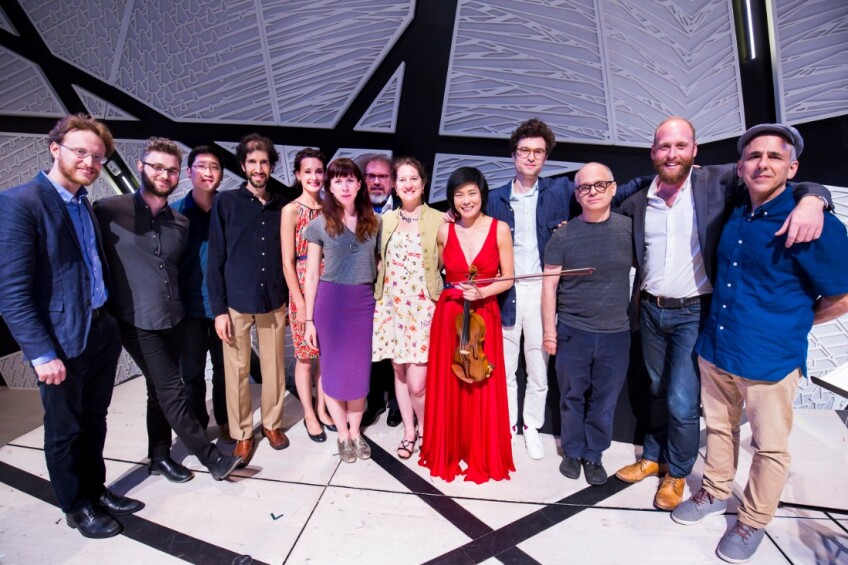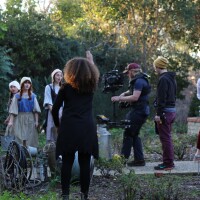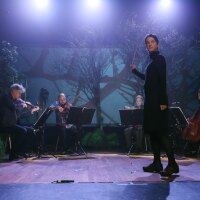A Violinist Evolving the Classical Mold

Vireo, the groundbreaking made-for-TV opera, is now available for streaming. Watch the 12 full episodes and dive into the world of Vireo through librettos, essays and production notes. Find more bonus content on KCET.org and LinkTV.org.
Classical violinists generally grow up learning the standard repertory, such as Bach, Tchaikovsky, Brahms and the like. And when one reaches the top rung as an international touring soloist, most audiences want to hear a fiddler perform works from the warhorse repertory. But Jennifer Koh is not like every violinist. While she does plenty of the familiar rep, she also believes that all the arts and music of the past and present form a kind of continuum.
To that end, the 40-year-old has premiered more than 50 works written especially for her, with a short list of commissions reading like a Rolodex of today’s hottest composers: included are Missy Mazzoli, John Harbison, Kaija Saariaho, Vijay Iyer, Andrew Norman and Esa-Pekka Salonen.

... the 40-year-old has premiered more than 50 works written especially for her, with a short list of commissions reading like a Rolodex of today’s hottest composers: included are Missy Mazzoli, John Harbison, Kaija Saariaho, Vijay Iyer, Andrew Norman and Esa-Pekka Salonen.
An only child born in Chicago to Korean parents, Koh was a prodigy who made her debut with the Chicago Symphony Orchestra at 11, going on to share the top prize in Moscow’s 1994 Tchaikovsky International Competition. She’s been heard with leading orchestras around the world, including the Los Angeles and New York Philharmonics, Cleveland Orchestra and Mariinsky Theatre, as well as having worked under the batons of such illustrious maestros/maestras as John Adams, Gustavo Dudamel and Marin Alsop.
Koh, who has a degree in English literature from Oberlin College and studied at the Curtis Institute, was Musical America’s 2016 Instrumentalist of the year. She can also be heard on numerous recordings showcasing works by a range of composers from Janáček, Bartók, and Kurtág to, of course, Bach and Schumann. Jennifer Higdon wrote her Grammy-nominated recording, “String Poetic,” expressly for the violinist.
New York-based Koh is also director of arco collaborative, an artist-driven nonprofit that fosters a better understanding of the world through music. Taking time from her rock star-like schedule, Koh recently spoke with KCET Artbound about a myriad of topics, including working with composers, being a woman in classical music and performing in “Vireo: The Spiritual Biography of a Witch's Accuser,” the new, made-for-TV-and-online opera composed by Lisa Bielawa.
What are you looking for when you commission a piece of music and is it always acceptable to you on first glance/play or is there some back and forth?
JK: There can always be back and forth. It depends on the composer, the kind of piece, and on so many different factors. What I will say is that I don’t look at myself as just premiering stuff and not caring about it. I really care about the birthing process. It’s not about my part, but it’s about really giving composers the space to be as creative as they want and need to be, and to take risks. It’s about wanting to reach beyond what you’ve done before. It is collaborative in that sense I suppose. Then we discuss notation and orchestration. But these are very long relationships that have been built up over the years and I’m very invested in the personal relationships that I have with these composers.
Let’s talk about “Shared Madness,” the 32 short works you commissioned - from as many composers - for solo violin as responses to Paganini. At that time you were trying to raise funds in order to purchase a violin you could perform on for the rest of your life, with the patrons Justus and Elizabeth Schlichting becoming involved. You met Justus in 2014 at UC Santa Barbara, where you performed a recital from your “Bach and Beyond” project, the series in which you surround Bach works with other solo pieces and new commissions.
JK: After that recital, Justus immediately said he liked the kinds of projects I was doing and was interested in commissioning work. They became wonderful supporters of new music and gave me a loan in which they agreed to be repaid in the form of commissions. So I went to my artist community of composers, and was so moved by their generosity, because they’re busy, and I believe they should be paid, of course. I was asking them a huge favor and always started the conversation with, ‘Please feel free to say no.’ They knew about the struggle I was having over the eight-year time period to be able to play on a decent instrument. Almost everyone said yes, and I was profoundly moved. That speaks to their generosity as artists and human beings.

Paganini published his 24 Caprices in 1820, when technique and virtuosity were, shall we say, fluid. You presented “Shared Madness” as part of the New York Philharmonic’s NY Phil Biennial in May of last year, with composers that included Julia Wolfe, Anthony Cheung and Jean-Baptiste Barrière. What were some of those three-minute works like?
JK: I was basically exploring the idea of what virtuosity is for the violin in the 21st century, as [opposed to being] defined by Paganini. I started questioning why are we still going by this definition of what virtuosity is, when the field of music has profoundly changed since the 1800s. Some people chose to engage directly with Paganini and some chose to explore extended techniques, which is an essential part of our language now. It was also artistically fascinating, and I think really interesting, to hear the multiplicity of responses to this.
To some, it was about phrasing. In Paganini’s time, maybe people couldn’t play fingered octaves. Some people had slower pieces because they believe phrasing is something that’s lost now. Some were defined in that kind of form - exploring lyricism. Some went the virtuosic route in terms of technically difficult pieces, some used electronics [which is] what made the project incredibly interesting in the end. For me, it’s a pleasure to work with composers, not an obligation.
You’ve undertaken a slew of projects, including “Bridge to Beethoven,” a recital series with pianist Shai Wosner that explores the impact and significance of Beethoven on a diverse group of composers and musicians. Then there’s your performance in the 2012 revival and tour of “Einstein on the Beach,” the 1976 opera by Philip Glass - who went on to write music for you - and the director Robert Wilson. You were also the first woman – and Asian – to perform the titular role, with reviews nothing short of raves. The New York Times’ Anthony Tommasini wrote: “It was wonderful to see the brilliant violinist Jennifer Koh, whose repertory ranges from Bach to flinty contemporary pieces, throw herself into the bewigged role of the violin-playing Einstein. Both Ms. Koh’s playing and her acting were gripping.” What was the experience like for you?
JK: I love Philip! When I auditioned for “Einstein” that was the first time I met him, and it was in his living room. It was a whole line-up [as] they had multiple people going in and they filmed it. Those things were sent to Wilson and he wanted to see me, but it was complicated because of the dates. They wanted me to play the role of Einstein, but [since] classical music is booked out two years in advance, I couldn’t do all their dates. So they had another violinist, especially in the beginning.
I also fell in love with Bob [Wilson]. I think he had the vision that it would work. He didn’t care if I was female or Asian, he knew immediately that I should be in the production. It was a profound experience to work with him. I felt I related to him a lot. He deals with a hundred people – stage crew, dancers, much less cast – and his process is reaching his vision [which] is similar to what I do. He does not stop until he sees his vision realized; It’s that kind of perfectionism. In that work process, he always got to the hall first and left last. He can be seen as demanding, and he wants the same dedication from everybody else. I felt a profound kinship with him.

You’re in episode ten of “Vireo,” featured as a solitary violinist playing in a storm that was shot at a green screen studio in Los Angeles. Curiously, you became close with composer Lisa Bielawa through “Einstein.” Can you talk about your participation in “Vireo?”
JK: I had just premiered Chris Rountree’s concerto and it was early in the morning last October, and that music you hear in “Vireo” is what Lisa [Bielawa] wrote for “Shared Madness.” So it was, in a sense, an exchange. For me being part of it was also an exchange. I knew her as a composer before, but we became closer as humans beings through “Einstein.” We would be put together in dressing rooms and became close through that process. Lisa was so already in the world and she was already writing “Vireo” during this period of time, so I think this came organically. She might have had the larger concept about it fitting into the opera at large, but that part didn’t come until later.
You’ll be premiering a new work by Vijay Iyer at the Ojai Festival, June 8, with International Contemporary Ensemble (ICE), conducted by Steve Schick. Iyer’s work is part of your larger project, “Mixtape,” a violin concerto commissioning project that asks composers to engage with American contemporary musical culture integral to their musical lives. In addition to Iyer, who is also the Ojai Music Festival’s director this year, composers engaged to be part of the project include Andrew Norman and Chris Cerrone. What was the genesis of “Mixtape?”
JK: Vijay’s concerto is called “Trouble” and I was thinking, ‘What is the point of a work of music?’ It reflects its time period, but also emotionally captures experiences – that you can bring people to an emotional place they don’t have every day. The purpose for me in live performance – and also for me as an audience – is to get to a place where you have a communal shared experience, where everyone is very present and not distracted, but to have an experience outside your everyday one. What I wanted with “Mixtape” and Vijay’s piece is part of that – is how do we encapsulate that, being two people of color?
The second movement is named after Vincent Chin, which I asked Vijay to do, because that was a profound moment in my life. It happened in the 80s when there was a lot of fear, and this Chinese-American man was beaten to death in Detroit by car manufacturing workers, because they thought he was Japanese, when Japan was becoming an economic powerhouse. I wanted Vijay’s piece to [convey] that very human experience. When you have that point of discovery, it’s racism, and being judged purely and violently not on who you are. I would have been eight at the time of Chin’s death, and I remember it so distinctly. I wanted to engage with Tamir Rice’s death, who was shot by police because he was playing with a toy gun. How does it affect community, how does it resonate within you for the rest of your life?
On a musical level I’m asking, ‘What is the form of the concerto?’ All these projects aren’t only dealing with social ideas, but dealing with form – a musical aspect that is continuous throughout. I wanted to encapsulate this artistically – that feeling, that emotional resonance in a work of art. Let’s hope in the future, in a 100 years, it doesn’t exist - I don’t know if it’s going to happen, or in 200 years - that these sorts of acts of violence based on race aren’t happening. That’s what “Mixtape” is.
You put your violin where your mouth is, so to speak, meaning you’re committed to seeing more diversity and gender equality in classical music.
JK: I happen to play the violin because my parents, who came from Korea, decided to make the effort when I was really young. You see that these experiences affect who you are as a human being and as a musician. I believe the same thing about composers and throughout the arts.
"You want to hear those different voices. I also believe it’s my duty that the art form is reflecting our society at large, the community at large."
You want to hear those different voices. I also believe it’s my duty that the art form is reflecting our society at large, the community at large.
You and I are now discussing females and Kaija Saariaho said that 50 percent of humanity has something to say. You think about the world at large and the diversity of cultures. How do we make our art form relevant in this very globalized world. I think the only way that happens is through the investment of new music and investing in performers and giving them those opportunities, both to composers and performers.
As a highly successful concertizing musician who happens to be female, can you talk about gender parity in the arena of classical music?
JK: It’s societal, and lately, I’ve been having more of these kinds of conversations. As women, I do think our experiences are very different and it’s important that structurally, women need to go into high-level administration. We have to keep talking about it. When I was younger, I felt completely alone, because no one talked about these things. When [Donald Trump’s] “Access Hollywood” tape came out, I wasn’t surprised at all. I did a residency at Oberlin recently and taught several courses and some of the symposiums. One was diversity in the arts and another was autonomy and economics for artists.
One of the things that came up was how do you change the fields you’re in, not only in terms of diversity, but male versus female. Students are curious about how you actually do that and they have a will to change the field.
You’re so passionate about what you do. What are your thoughts about the state of classical music today?
JK: The most important thing for me is to think about the art form itself, which is why I’m so committed to working with composers, and that future is dependent on work being made now. Otherwise we would just preserve old works, like calcified museum pieces. But there’s also no guarantee with new works. It’s not like you order a sandwich at the same deli and it’s always going to be the same. There’s always a risk. Also, you could die before the piece is completed, but there are just risks in life. What’s most important is that music is a living and breathing art form, and the art form itself and the artists themselves, have always engaged and found points of inspiration from everywhere.
I never understood why, first of all, as a performer, one would just simply play the same things all their lives. It felt weird to me to stop learning things. I went through the standard repertory at 16, and why would I stop learning new work? Beyond that, it is a question of what we give to our communities and our society and to our art form. Part of that is giving voice to people that don’t have a voice. As a performer that’s literally performing composers whose works can only live through performance. It also means for me, at least, bringing in composers. I do a lot of research and I fly a lot to hear live composers’ different works. It’s about really seeking out not only individual voices but also diverse voices, because if they’re not given those opportunities, they don’t have the freedom to grow.
Top Image: Chris Lee


